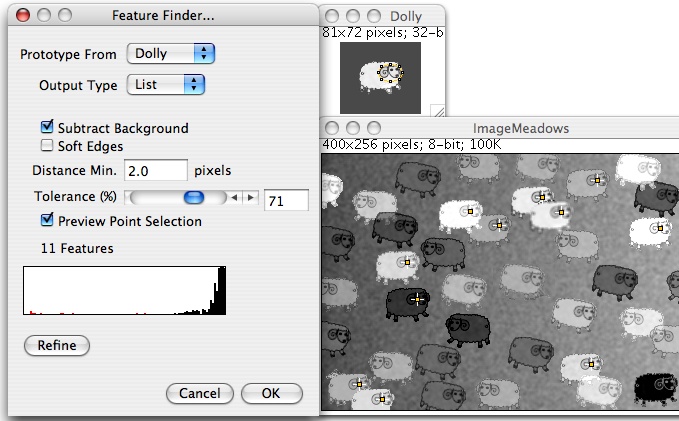Feature Finder
An ImageJ template matching plugin, finds features equal or similar to a prototype (template). “Similarity” means that the mean square deviation between the image and the translated prototype should be low.
What’s nice about it
- After a (slow) initial calculation, preview provides a fast way to determine the similarity threshold.
- Subpixel accuracy.
- During preview, possibility to refine the prototype by averaging over features found.
Limitations
- Works with grayscale images only; any calibration of pixel values is ignored.
- Only searches for unrotated (or circular) and unscaled features.
- Slow except for small prototypes (brute-force algorithm, no FFT).
- During preview, while the prograss bar is active: don’t change any input in the dialog box, otherwise it will restart and take even longer.
- Does not process stacks.
Dialog Options

- Prototype from selects the prototype. This can be a ROI of the current image or a different image.
- Output Type can be:
- Point Selection: A Point ROI of the centers of all features.
- Count: The number of features found is written to the Results Table.
- List: A list of x and y pixel coordinates of the centers is written to the Results Table.
- List (calibrated): like as ‘List’, but writes calibrated x and y coordinates to the Results Table.
- Point Map: A separate binary image with one pixel=255 at the center of each feature.
- Deviation Map: A separate float (32-bit) image. The value at each point indicates how much the surroundings of this position in the original image deviate from the prototype. The Deviation Map is independent of the ‘Tolerance’ settings.
- Average of Features: A separate float (32-bit) output image with the average of all features shifted to the same position.
- With Subtract Background, features are considered the same independent of any constant (additive) background.
- Soft Edges gives less weight to the near-edge pixels of the prototype than to those near the center.
- If features are close together, closer than Distance Min, then only the one with the best match is kept.
- Tolerance determines how much a feature may deviate from the prototype. A value of 0 means an exact match, 100 means that the deviation equals the variance of the prototype. With ‘Subtract Background’ on, at a tolerance of 100% also image areas with a constant value over the prototype area qualify as features.
- During preview, after setting the tolerance you may press the Refine button. This calculates a new prototype from the average of all features currently selected. ‘Refine’ is useful, e.g., if the prototype suffers from noise.
During preview, the dialog also displays a histogram of the number of features vs. deviation from the prototype and a message with the number of features found. (Due to a Java bug, updating of the number of features may sometimes fail with Mac OS X.)
Tips and tricks
- During preview, the histogram often shows a broad peak at the right side. These are the false matches. Keep the threshold below this peak.
- Features should have the same gray level contrast as the prototype. If this is not the case, it is advisable to select a template with the highest contrast that may occur in the image.
- If thresholding fails, you can also try to create a Deviation Map and work on it (background subtraction, high-pass filter, find maxima …)
Download
- Source code
Feature_Finder.javaon GitHub (make sure you download the raw file, use the button near the top right)
Installation
- Copy the raw
Feature_Finder.javafile into the ImageJ plugins folder or a subfolder thereof. Make sure that you name the downloaded file ”Feature_Finder.java”; uppercase/lowercase matters. - Compile with “Compile and Run” and press “OK”. Note that “Compile and Run” is currently broken on Fiji; as a workaround use File>New>Script, open the
Feature_Finder.javafile and press “Run“. - Use Help>Update Menus or restart ImageJ to make it appear in the Plugins menu (not necessary if you have used the Fiji Script Editor).
License
GNU General Public License v2, v3 or later
Version history
- Version 2010-Dec-28, Michael Schmid: Plugin released
- Version 2012-Dec-23, Michael Schmid: Uses parallel processing on multi-core machines (faster)
- Version 2020-Mar-13, Michael Schmid: Non-blocking dialog; output type ‘List (calibrated)’ added